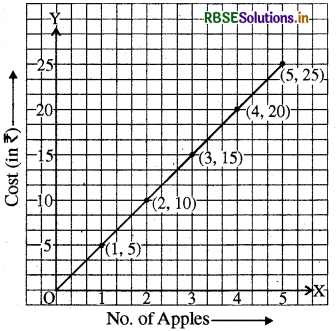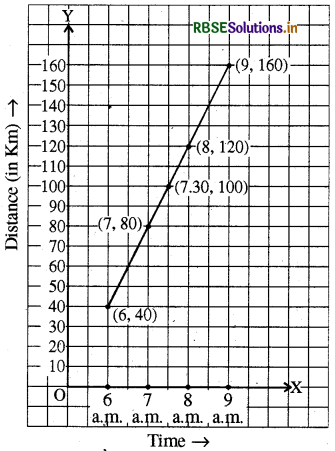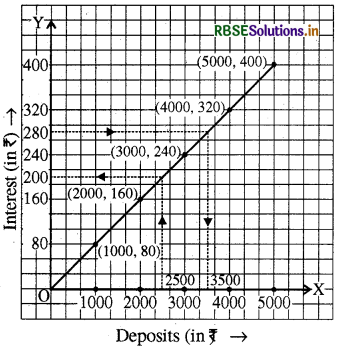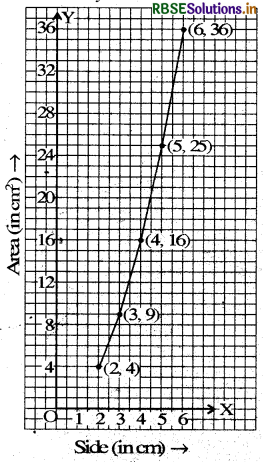RBSE Solutions for Class 8 Maths Chapter 15 Introduction to Graphs Ex 15.3
Rajasthan Board RBSE Solutions for Class 8 Maths Chapter 15 Introduction to Graphs Ex 15.3 Textbook Exercise Questions and Answers.
RBSE Class 8 Maths Solutions Chapter 15 Introduction to Graphs Ex 15.3
Question 1.
Draw the graphs for the following tables of values, with suitable scales on the axes.
(a) Cost of apples

Scale : x-axis : 1 unit = 1 apple
y-axis : 1 unit = ₹ 5 Here, 10 small dievsions = 1 unit
Steps :
(i) We mark no. of apples along x-axis.
(ii) Then we mark cost (in T) along y-axis.
(iii) Plot the points as shown in graph.
(iv) We join the points (1, 5), (2, 10), (3, 15),

(b) Distance travelled by a car

(i) How much distance did the car cover during the period 7.30 a.m. to 8 a.m?
(ii) What was the time when the car had covered a distance of 100 km since it’s start?
Answer:
Scale : 2 units = 1 hour (x-axis)
1 unit = 10 km (y-axis)
In order to draw time-distance graph, we represent the time (in hours) on x-axis and the distance (in km) on y-axis.
We plot the points (6, 40), (7, 80), (8, 120) and (9, 160). Then we join them by line segments to get the required graph.
(i) From the graph, distance covered by die car during 7.30 a.m. to 8.00 a.m. is 20 km. (∵ 120 - 100 = 20 km.)
(ii) The time, when the car had covered 100 km since it’s start is 7.30 a.m.

(c) Interest on deposits for a year.

(i) Does the graph pass through the origin?
(ii) Use the graph to find the interest on ₹ 2500 for a year.
(iii) To get an interest of ₹ 280 per year, how much money should be deposited?
Answer:
(1) First we draw the axes.
(2) Scale : 1 unit = ₹ 1000 (x-axis)
1 unit = 80 (y-axis)
(3) Then, we plot the points (1000, 80), (2000, 160), (3000, 240), (4000, 320) and (5000, 400).
(4) We joint these points to get the required graph.
From graph
(i) This graph (line) passes through origin.
(ii) Interest from ₹ 2500 is ₹ 200.
(iii) To get ₹ 280 interest per year we have to deposite ₹ 3500.


Question 2.
Draw a graph for the following:
(i)

Is it a linear graph?
Answer:

Scale : 1 unit = 1 cm (along x-axis)
1 unit = 4 cm (along y-axis)
Now, we plot the points (2, 8), (3, 12), (3.5, 14), (5, 20), (6, 24) and join these points to obtain the required graph.
Yes, it is a linear graph as the graph is a straight line.
(ii)

Is it a linear graph?
Answer:
We take the side of the square along the x-axis and arda (in cm2) along the y-axis. Now, plot the points (2, 4), (3, 9), (4, 16), (5, 25) and (6, 36) as shown in the figure.
Scale : 1 unit on x-axis = 1 cm
1 unit on y-axis = 4 cm2

∵ The graph is not a straight
∴ It is not a linear graph.
